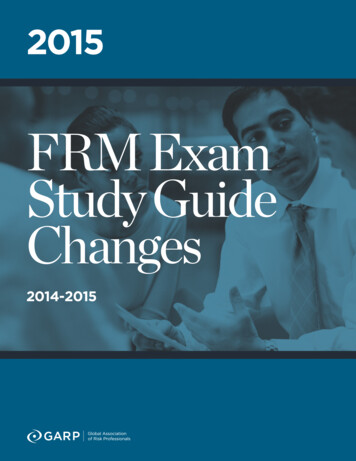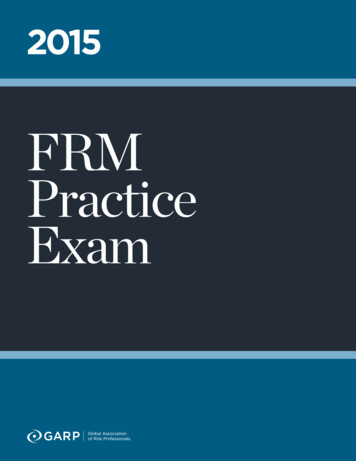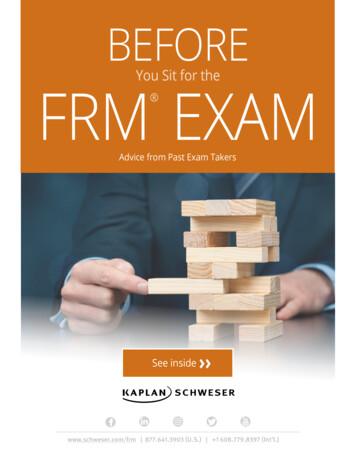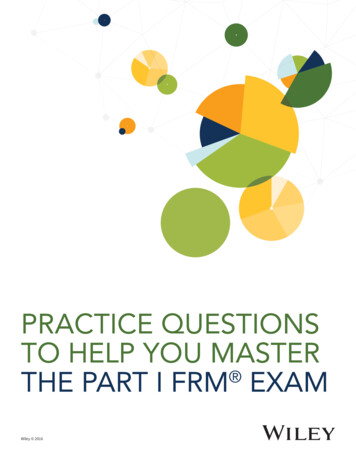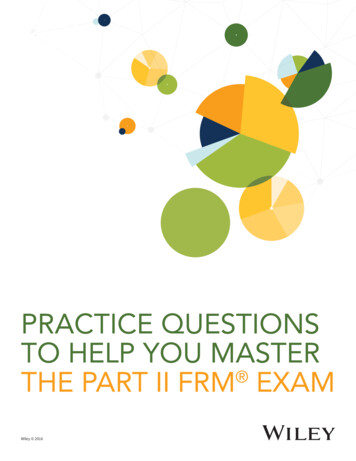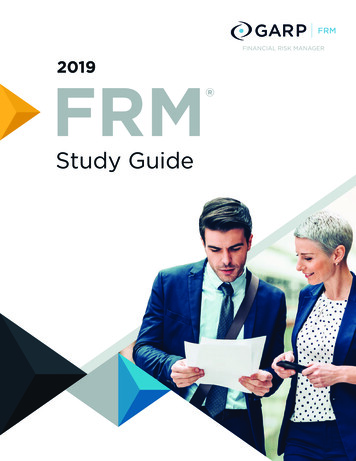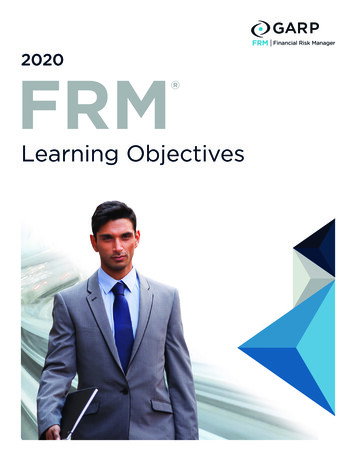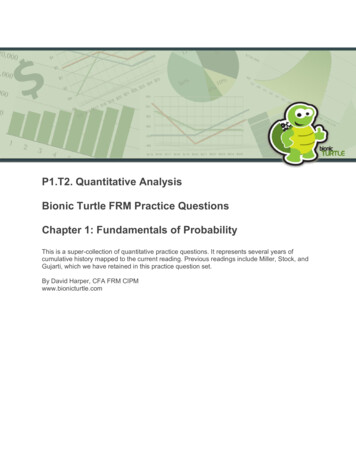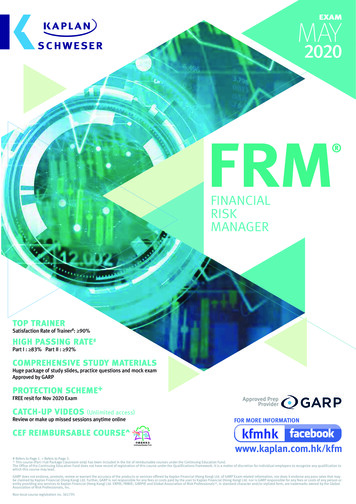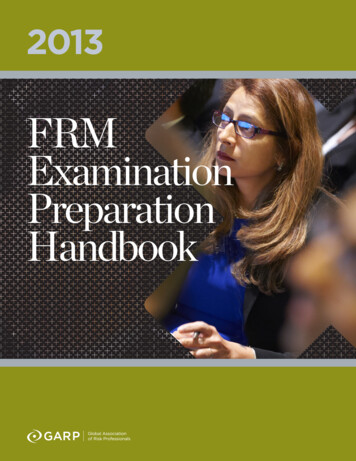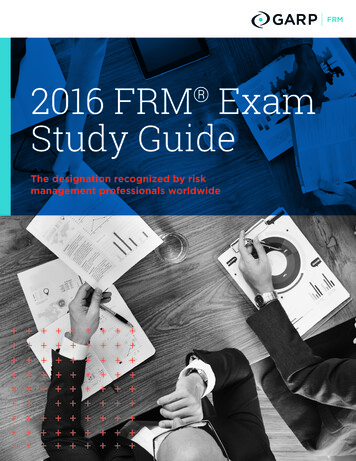
Transcription
2016 FRM ExamStudy Guide The designation recognized by riskmanagement professionals worldwide
2016 Financial Risk Manager (FRM ) Exam Study GuideTOPIC OUTLINE, READINGS,able to deal with them effectively. AsTEST WEIGHTINGSsuch, the Exams are comprehensive inThe Study Guide sets forth primarynature, testing a candidate on a numbertopics and subtopics covered in the FRMof risk management concepts andExam Part I and Part II. The topics wereapproaches.selected by the FRM Committee as onesthat risk managers who work in practicetoday have to master. The topics andREADINGSQuestions for the FRM Exams are relatedtheir respective weightings are reviewedto and supported by the readings listedyearly to ensure the Exams are timelyunder each topic outline. These readingsand relevant. The study Guide alsowere selected by the FRM Committeecontains a full listing of all the readingsto assist candidates in their review ofthat are recommended as preparationthe subjects covered by the Exams. It isfor the FRM Exam Part I and Part II.strongly suggested that candidates reviewKey concepts (knowledge points)these readings in depth prior to sitting forappear as bullet points at the beginningeach exam. All of the readings listed in theof each section and are intended to helpFRM Study guide are available throughcandidates identify the major themesGARP. Further information can be foundand knowledge areas associated withon the GARP website.that section.FRM EXAM PREP PROVIDERSFRM EXAM APPROACHThe FRM Exams are practice-oriented.Some candidates may want to moreformally review the materials with FRMThe questions are derived from aPreparation Providers (EPPs). A list ofcombination of theory, as set forth inEPPs that have registered with GARP canthe readings, and “real-world” workbe found at the GARP website. GARPexperience. Candidates are expecteddoes not endorse any Exam Preparationto understand risk managementProvider but merely lists them as aconcepts and approaches, and howservice to FRM candidates.they would apply to a risk manager’sday-to-day activities. It is rare that arisk manager will be faced with an issuethat can immediately be slotted intoone category. In the real world, a riskmanager must be able to identify anynumber of risk-related issues and beIn the real world, a riskmanager must be able toidentify any number of riskrelated issues and be able todeal with them effectively.On the following pages, an asterisk after a reading title indicates that the readingis freely available on the GARP website. 2016 Global Association of Risk Professionals. All rights reserved.3
2016 Financial Risk Manager (FRM ) Exam Study GuideFRM Exam Part ITopics and ReadingsFoundations of Risk ManagementPart I Exam Weight 20%4 Basic risk types, measurement and management tools Creating value with risk management The role of risk management in corporate governance Enterprise Risk Management (ERM) Financial disasters and risk management failures The Capital Asset Pricing Model (CAPM) Risk-adjusted performance measurement Multi-factor models Information risk and data quality management Ethics and the GARP Code of Conduct 2016 Global Association of Risk Professionals. All rights reserved.
2016 Financial Risk Manager (FRM ) Exam Study GuideReadings for Foundations of Risk Management1.Michel Crouhy, Dan Galai, and Robert Mark, The Essentials of Risk Management, 2nd Edition (New York:McGraw-Hill, 2014). Chapter 1. Risk Management: A Helicopter View (Including Appendix 1.1. Typology of Risk Exposures) Chapter 2. Corporate Risk Management: A Primer Chapter 4. Corporate Governance and Risk Management2.James Lam, Enterprise Risk Management: From Incentives to Controls, 2nd Edition (Hoboken, NJ: JohnWiley & Sons, 2014). Chapter 4. What is ERM?3.René Stulz, “Governance, Risk Management and Risk-Taking in Banks,” Finance Working Paper427/2014 (June 2014).4.Steve Allen, Financial Risk Management: A Practitioner’s Guide to Managing Market and Credit Risk,2nd Edition (New York: John Wiley & Sons, 2013). Chapter 4. Financial Disasters5.John Hull, Risk Management and Financial Institutions, 4th Edition (Hoboken: John Wiley & Sons, 2015) Chapter 6. The Credit Crisis of 20076.René Stulz, “Risk Management Failures: What are They and When Do They happen?” Fisher College ofBusiness Working Paper Series, October 2008.7.Edwin J. Elton, Martin J. Gruber, Stephen J. Brown and William N. Goetzmann, Modern Portfolio Theoryand Investment Analysis, 9th Edition (Hoboken, NJ: John Wiley & Sons, 2014). Chapter 13. The Standard Capital Asset Pricing Model8.Noel Amenc and Veronique Le Sourd, Portfolio Theory and Performance Analysis (West Sussex, England: John Wiley & Sons, 2003). Chapter 4. Applying the CAPM to Performance Measurement: Single-Index Performance MeasurementIndicators (Section 4.2 only)9.Zvi Bodie, Alex Kane, and Alan J. Marcus, Investments, 10th Edition (New York: McGraw-Hill, 2013). Chapter 10. Arbitrage Pricing Theory and Multifactor Models of Risk and Return10. Anthony Tarantino and Deborah Cernauskas, Risk Management in Finance: Six Sigma and Other NextGeneration Techniques (Hoboken, NJ: John Wiley & Sons, 2009). Chapter 3. Information Risk and Data Quality Management11. “Principles for Effective Data Aggregation and Risk Reporting,” (Basel Committee on Banking Supervision Publication, January 2013).12. GARP Code of Conduct.* 2016 Global Association of Risk Professionals. All rights reserved.5
2016 Financial Risk Manager (FRM ) Exam Study GuideFRM Exam Part ITopics and ReadingsQuantitative AnalysisPart I Exam Weight 20% Discrete and continuous probability distributions Estimating the parameters of distributions Population and sample statistics Bayesian analysis Statistical inference and hypothesis testing Correlations and copulas Estimating correlation and volatility using EWMA andGARCH models6 Volatility term structures Linear regression with single and multiple regressors Time series analysis Simulation methods 2016 Global Association of Risk Professionals. All rights reserved.
2016 Financial Risk Manager (FRM ) Exam Study GuideReadings for Quantitative Analysis13. Michael Miller, Mathematics and Statistics for Financial Risk Management, 2nd Edition (Hoboken, NJ:John Wiley & Sons, 2013). Chapter 2. Probabilities Chapter 3. Basic Statistics Chapter 4. Distributions Chapter 6. Bayesian Analysis (Pages 113-124 only) Chapter 7. Hypothesis Testing and Confidence Intervals14. John Hull, Risk Management and Financial Institutions, 4th Edition (Hoboken: John Wiley & Sons, 2015). Chapter 11. Correlations and Copulas15. James Stock and Mark Watson, Introduction to Econometrics, Brief Edition (Boston: Pearson, 2008). Chapter 4. Linear Regression with One Regressor Chapter 5. Regression with a Single Regressor Chapter 6. Linear Regression with Multiple Regressors Chapter 7. Hypothesis Tests and Confidence Intervals in Multiple Regression16. Francis X. Diebold, Elements of Forecasting, 4th Edition (Mason, Ohio: Cengage Learning, 2006). Chapter 5. Modeling and Forecasting Trend (Section 5.4 only—Selecting Forecasting Models Using theAkaike and Schwarz Criteria) Chapter 7. Characterizing Cycles Chapter 8. Modeling Cycles: MA, AR, and ARMA Models17. John Hull, Options, Futures, and Other Derivatives, 9th Edition (New York: Pearson, 2014). Chapter 23. Estimating Volatilities and Correlations for Risk Management18. Chris Brooks, Introductory Econometrics for Finance, 3rd Edition (Cambridge, UK: Cambridge University Press, 2014). Chapter 13. Simulation Methods (Note: EViews and other programming references are not required). 2016 Global Association of Risk Professionals. All rights reserved.7
2016 Financial Risk Manager (FRM ) Exam Study GuideFRM Exam Part ITopics and ReadingsFinancial Markets and ProductsPart I Exam Weight 30% Structure and mechanics of OTC and exchange markets Structure, mechanics, and valuation of forwards, futures,swaps and options8 Hedging with derivatives Interest rates and measures of interest rate sensitivity Foreign exchange risk Corporate bonds Mortgage-backed securities Rating agencies 2016 Global Association of Risk Professionals. All rights reserved.
2016 Financial Risk Manager (FRM ) Exam Study GuideReadings for Financial Markets and Products19. John Hull, Options, Futures, and Other Derivatives, 9th Edition (New York: Pearson, 2014). Chapter 1. Introduction Chapter 2. Mechanics of Futures Markets Chapter 3. Hedging Strategies Using Futures Chapter 4. Interest Rates Chapter 5. Determination of Forward and Futures Prices Chapter 6. Interest Rate Futures Chapter 7. Swaps Chapter 10. Mechanics of Options Markets Chapter 11. Properties of Stock Options Chapter 12. Trading Strategies Involving Options Chapter 26. Exotic Options20. Robert McDonald, Derivatives Markets, 3rd Edition (Boston: Pearson, 2012). Chapter 6. Commodity Forwards and Futures21. Anthony Saunders and Marcia Millon Cornett, Financial Institutions Management: A Risk ManagementApproach, 8th Edition (New York: McGraw-Hill, 2014). Chapter 13. Foreign Exchange Risk22. Jon Gregory, Central Counterparties: Mandatory Clearing and Bilateral Margin Requirements for OTCDerivatives (West Sussex, UK: John Wiley & Sons, 2014). Chapter 1. Introduction Chapter 2. Exchanges, OTC Derivatives, DPCs and SPVs Chapter 3. Basic Principles of Central Clearing Chapter 14 (section 14.4 only). Risks Caused by CCPs: Risks Faced by CCPs23. Frank Fabozzi (editor), The Handbook of Fixed Income Securities, 8th Edition (New York:McGraw-Hill, 2012). Chapter 12. Corporate Bonds, by Frank Fabozzi, Steven Mann and Adam Cohen24. Bruce Tuckman, Angel Serrat, Fixed Income Securities: Tools for Today’s Markets, 3rd Edition (Hoboken: Wiley, 2011). Chapter 20. Mortgages and Mortgage-Backed Securities25. John B. Caouette, Edward I. Altman, Paul Narayanan, and Robert W.J. Nimmo, Managing Credit Risk:The Great Challenge for Global Financial Markets, 2nd Edition (New York: John Wiley & Sons, 2008). Chapter 6. The Rating Agencies 2016 Global Association of Risk Professionals. All rights reserved.9
2016 Financial Risk Manager (FRM ) Exam Study GuideFRM Exam Part ITopics and ReadingsValuation and Risk ModelsPart I Exam Weight 30%10 Value-at-Risk (VaR) Expected shortfall (ES) Stress testing and scenario analysis Option valuation Fixed income valuation Hedging Country and sovereign risk models and management External and internal credit ratings Expected and unexpected losses Operational risk 2016 Global Association of Risk Professionals. All rights reserved.
2016 Financial Risk Manager (FRM ) Exam Study GuideReadings for Valuation and Risk Models26. Linda Allen, Jacob Boudoukh and Anthony Saunders, Understanding Market, Credit, and OperationalRisk: The Value at Risk Approach (New York: Wiley-Blackwell, 2004). Chapter 2. Quantifying Volatility in VaR Models Chapter 3. Putting VaR to Work27. Kevin Dowd, Measuring Market Risk, 2nd Edition (West Sussex, England: John Wiley & Sons, 2005). Chapter 2. Measures of Financial Risk28. John Hull, Options, Futures, and Other Derivatives, 9th Edition (New York: Pearson, 2014). Chapter 13. Binomial Trees Chapter 15. The Black-Scholes-Merton Model Chapter 19. Greek Letters29. Bruce Tuckman, Fixed Income Securities, 3rd Edition (Hoboken, NJ: John Wiley & Sons, 2011). Chapter 1. Prices, Discount Factors, and Arbitrage Chapter 2. Spot, Forward and Par Rates Chapter 3. Returns, Spreads and Yields Chapter 4. One-Factor Risk Metrics and Hedges Chapter 5. Multi-Factor Risk Metrics and Hedges30. Aswath Damodaran, “Country Risk: Determinants, Measures and Implications - The 2015 Edition”(July 14, 2015). (Pages 1-45 only).31. Arnaud de Servigny and Olivier Renault, Measuring and Managing Credit Risk (New York:McGraw-Hill, 2004). Chapter 2. External and Internal Ratings32. Gerhard Schroeck, Risk Management and Value Creation in Financial Institutions (New York:John Wiley & Sons, 2002). Chapter 5. Capital Structure in Banks (Pages 170-186 only)33. John Hull, Risk Management and Financial Institutions, 4th Edition (Hoboken, NJ: John Wiley &Sons, 2015). Chapter 23. Operational Risk34. Philippe Jorion, Value-at-Risk: The New Benchmark for Managing Financial Risk, 3rd Edition (New York:McGraw-Hill, 2007). Chapter 14. Stress Testing35. “Principles for Sound Stress Testing Practices and Supervision” (Basel Committee on BankingSupervision Publication, May 2009). 2016 Global Association of Risk Professionals. All rights reserved.11
2016 Financial Risk Manager (FRM ) Exam Study GuideFRM Exam Part IITopics and ReadingsMarket Risk Measurementand ManagementPart II Exam Weight 25% VaR and other risk measures Parametric and non-parametric methods of estimation VaR mapping Backtesting VaR Expected shortfall (ES) and other coherent risk measures Extreme value theory (EVT)12 Modeling dependence: Correlations and copulas Term structure models of interest rates Discount rate selection Volatility: Smiles and term structures 2016 Global Association of Risk Professionals. All rights reserved.
2016 Financial Risk Manager (FRM ) Exam Study GuideReadings for Market Risk Measurement and Management36. Kevin Dowd, Measuring Market Risk, 2nd Edition (West Sussex, England: John Wiley & Sons, 2005). Chapter 3. Estimating Market Risk Measures: An Introduction and Overview Chapter 4. Non-parametric Approaches Chapter 7. Parametric Approaches (II): Extreme Value37. Philippe Jorion, Value-at-Risk: The New Benchmark for Managing Financial Risk, 3rd Edition (New York:McGraw-Hill, 2007). Chapter 6. Backtesting VaR Chapter 11. VaR Mapping38. “Messages from the Academic Literature on Risk Measurement for the Trading Book,” Basel Committeeon Banking Supervision, Working Paper No. 19, Jan 2011.39. Gunter Meissner, Correlation Risk Modeling and Management (New York: John Wiley & Sons, 2014). Chapter 1. Some Correlation Basics: Properties, Motiva
The FRM Exams are practice-oriented. The questions are derived from a combination of theory, as set forth in the readings, and “real-world” work experience. Candidates are expected to understand risk management concepts and approaches, and how they would apply to


